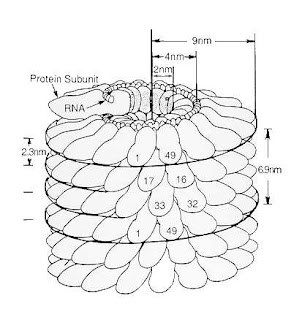The rule of six (Ro6) describes a requirement for particular viruses to have a genome length with a multiple of six. The viruses that have been proved to prescribe to this rule our the members of the Paramyxoviridae, such as: nipah virus, human parainfluenza virus 2, sendai virus (and here) and human parainfluenza virus 3. But, based on simply counting the number of nucleotides within the genome, it could extend to many more viruses within this family and outside of it, like ebola virus.
 |
| The structure of a paramyxovirus particle. Inside lies the genomic RNA encased within N, P and L proteins. Each N protein binds to 6 RNA nucleotides along the single molecule. Loney et al, 2009. |
These enveloped, single-stranded, non-segmented, negative sense RNA viruses are encased in a protein coat composed of at least three proteins: nucleocapsid (N), phosphoprotein (P) and the large (L) polymerase protein.
Following entry inside our cells (after binding to receptors on the surface and fusion of the envelope), these viruses begin a genetically defined program that results in the generation of thousands and thousands of new virus particles being released from each cell. In order to achieve this, their genomic RNA must be replicated. And, for this to begin, transcription must take place initially before replication as the genome is negative sense while mRNA's are postive-sense.
 |
| Typical schematic of N binding to RNA genome. 6 nucleotides to 1 N protein. http://application.fnu.ac.fj |
This RNA synthesis is carried out by the very same proteins found in the virus genome coat - N, P and L, which effectively read off each gene along the genome into mRNA molecules, which are translated by the host machinery into viral proteins.
Once a certain level of viral proteins is reached within the cell, the virus switches over to genome replication - an extended version of mRNA synthesis incorporating the entire molecule without stopping. A full-length positive-sensed copy - the antigenome- is thus generated (opposite to the genomic negative sense) which is subsequently used to synthesize a full-length genomic RNA molecule that is rapidly encased within its own N, P and L protein coat. These nucleoprotein complexes are what is put inside new virus particles that bud out of the host cell's plasma membrane.
 |
| How measles virus - a paramyxovirus - replicates. Notice mRNA synthesis immediately following entry, THEN replication. |
In order for this entire process to be efficient at generating full-length genomic and antigenomic molecules (and hence mRNA molecules), the genome must effectively be enclosed within its protein coat, specifically N proteins. Without this, the virus replication machinery finds it difficult to begin replication. Each N molecule associates with exactly 6 nucleotides, which gets us to the reason as to why these viruses require their genomes to be a multiple of six. If they weren't, genome synthesis would be inefficient and infection may fail and hence natural selection may favour efficient RNA synthesis. It may also have something to do with the position of the RNA bases relative to the N subunits. Or error catastrophe.
This being said, not all paramyxoviruses are as stringent about the rule of six as most others. Some are happy at being a bit longer/shorter.
















